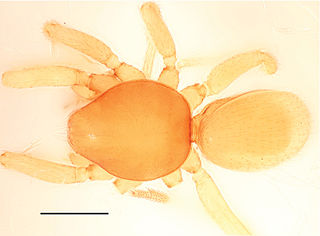
Oonopidae, also known as goblin spiders, is a family of spiders consisting of over 1,600 described species in about 113 genera worldwide, with total species diversity estimated at 2000 to 2500 species. The type genus of the family is OonopsKeyserling, 1835.

The Farquhar Group belong to the Outer Islands of the Seychelles, lying in the southwest of the island nation, more than 700 km (430 mi) southwest of the capital, Victoria, on Mahé Island.

Unicorn ("one horn", in Latin) is a genus of goblin spiders from South America, containing seven species that occur predominantly in high elevation, semi-desert regions of Bolivia, Chile, and Argentina. Individuals are relatively large for goblin spiders, measuring up to 3.0 mm (0.12 in) in body length. The genus name refers to a characteristic pointed projection between the eyes and jaws of males. In at least one species, broken-off tips of the male pedipalps have been found within the genitalia of females, postulated as a means of sperm competition. Unicorn possesses several traits that suggest it is a relatively "primitive" member of the Oonopidae, and is classified with other similar, soft-bodied goblin spiders in the subfamily Sulsulinae.
Predatoroonops is a genus of goblin spiders endemic to the Brazilian Atlantic Forest. The genus is characterized by the extremely modified male chelicerae and long pairs of ventral spines. It is the first fully revised endemic Brazilian genus of spiders, uncovered in 2012 after two and a half years of research at São Paulo's Instituto Butantan.

Bannana is a genus of goblin spiders native to Xishuangbanna prefecture, Yunnan Province, China, where it lives in the leaf-litter of tropical rainforest. There are two known species: Bannana crassispina and B. parvula, both described in 2015. Individuals are pale yellow and unpatterned, and range from around 1.0 to 1.8 mm in body length, with females being slightly larger than males. The eyes are reduced or entirely absent. Known only from a nature reserve in Xishuangbanna, Bannana belongs to a group of Asian goblin spiders known as the "Dysderoides complex", that ranges from China to Pakistan and south to Indonesia.
Cortestina is a genus of spiders in the family Oonopidae. It was first described in 2009 by Knoflach. As of 2017, it contains only one species, Cortestina thaleri, found in Austria and Italy.
Cousinea is a genus of spiders in the family Oonopidae. It was first described in 2001 by Saaristo. As of 2017, it contains only one species, Cousinea keeleyi, found in the Seychelles.
Hypnoonops is a genus of spiders in the family Oonopidae. It was first described in 1977 by Benoit. As of 2017, it contains only one species, Hypnoonops lejeunei found in Congo.
Hytanis is a genus of spiders in the family Oonopidae. It was first described in 1893 by Simon. As of 2017, it contains only one species, Hytanis oblonga, found in Venezuela.
Kapitia is a genus of spiders in the family Oonopidae. It was first described in 1956 by Forster. As of 2017, it contains only one species, Kapitia obscura.
Nephrochirus is a genus of spiders in the family Oonopidae. It was first described in 1910 by Simon. As of 2017, it contains only one species, Nephrochirus copulatus, collected in Namibia.
Plectoptilus is a genus of spiders in the family Oonopidae. It was first described in 1905 by Simon. As of 2017, it contains only one species, Plectoptilus myops, found on Java.
Pseudoscaphiella is a genus of spiders in the family Oonopidae. It was first described in 1907 by Simon. As of 2017, it contains only one species, Pseudoscaphiella parasita.
Sulsula is a genus of spiders in the family Oonopidae. It was first described in 1882 by Simon. As of 2017, it contains only one species, Sulsula pauper, found in Algeria, Egypt, and Sudan.

Tapinesthis is a genus of spiders in the family Oonopidae. It was first described in 1914 by Simon. As of 2017, it contains only one European species, Tapinesthis inermis.
Himalayana is a genus of spiders in the family Oonopidae. It was first described in 2014 by Grismado. As of 2017, it contains 6 species from India and Nepal.
Socotroonops is a genus of spiders in the family Oonopidae. It was first described in 2002 by Saaristo & van Harten. As of 2017, it contains only one species, Socotroonops socotra.
Sicariomorpha is a genus of spiders in the family Oonopidae. It was first described in 2015 by Ott & Harvey. As of 2017, it contains only one species, Sicariomorpha maschwitzi, found in Malaysia.
Amazoonops is a genus of spiders in the family Oonopidae. It was first described in 2017 by Ott, Ruiz, Brescovit & Bonaldo. As of 2017, it contains 5 species, all from Brazil.
Shuqiang Li is a Chinese arachnologist and a professor at the Institute of Zoology of the Chinese Academy of Sciences. Li is best known for his work with spiders and has described hundreds of new species and many genera. He is Editor in Chief of the journal Zoological Systematics.




